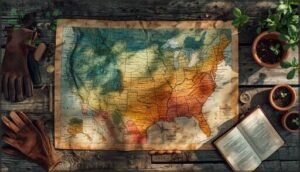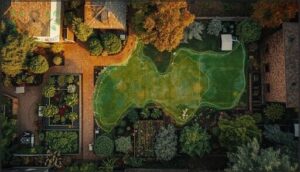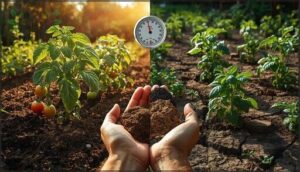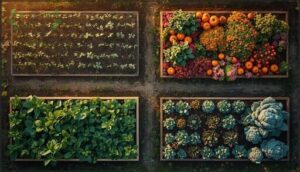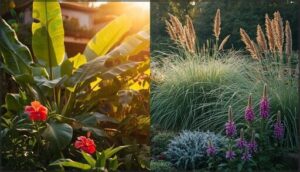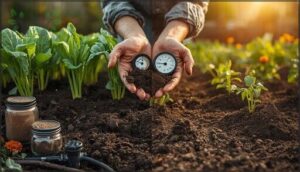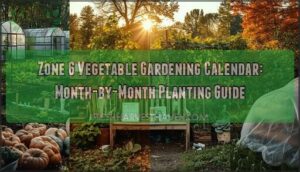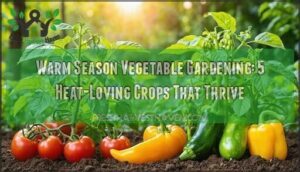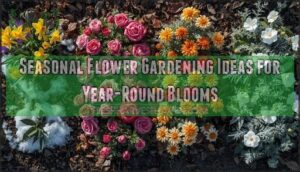This site is supported by our readers. We may earn a commission, at no cost to you, if you purchase through links.

Your tomato plants don’t care what the calendar says—they respond to soil temperature, frost dates, and daylight hours dictated by your specific climate zone. A crop that thrives in Zone 9’s mild winters will freeze solid in Zone 4’s brutal cold snaps, while cold-hardy kale that flourishes in northern gardens turns bitter and bolts in southern heat.
The USDA hardiness zones give you the temperature framework, but mastering seasonal gardening by climate zone means synchronizing every planting decision, every transplant date, and every protective measure with your region’s unique rhythm. You’ll outpace neighbors who follow generic advice once you align your garden tasks with the biological realities of your zone’s temperature patterns, frost windows, and growing season length.
Table Of Contents
Key Takeaways
- USDA hardiness zones provide the temperature survival framework for your garden, but true mastery requires synchronizing planting decisions with your zone’s specific frost dates, soil temperature thresholds, and growing season length rather than following generic calendar advice.
- Microclimates within your property—created by factors like south-facing walls, urban heat islands, elevation changes, and sheltered corners—can shift your effective growing conditions by multiple zones, allowing you to push boundaries and grow plants theoretically outside your zone’s range.
- Successful regional gardening depends on matching crops to your zone’s temperature extremes (selecting cold-hardy varieties for early plantings and heat-resilient types for summer), preparing soil through targeted amendments based on local composition, and implementing zone-specific pest management strategies that reflect your area’s dominant threats.
- Season extension techniques like row covers, cold frames, and high tunnels can add 2-8 weeks to your growing calendar by maintaining soil temperatures and protecting against frost, effectively shifting your hardiness zone and enabling year-round harvests in zones 7 and above.
What Are USDA Climate Zones?
You can’t master your garden until you know which rules you’re playing by—and USDA climate zones set those rules based on cold, hard temperature data. These zones tell you what survives winter in your area, not what thrives, but understanding how they’re mapped gives you the power to push boundaries and grow with confidence.
USDA climate zones define what survives winter in your garden, not what thrives, giving you the data to push boundaries confidently
Here’s what determines your zone, how the map works, and why those lines on the map keep shifting under your feet.
How Hardiness Zones Are Determined
You’re taking control of your garden’s success when you understand how hardiness zones get their power. The USDA zones emerge from rigorous meteorological analysis and data calibration, tracking what truly matters: survival.
The USDA Plant Hardiness Zone Map relies on:
- Temperature mapping from over 13,400 weather stations nationwide
- Zone classification using 30-year extreme minimum temperature averages
- GIS modeling that interpolates data for precise spatial boundaries
- Statistical calibration ensuring accuracy before publication
- 10°F increments dividing zones, with 5°F subzone refinements
Plant hardiness determination strips away guesswork, giving you science-backed confidence. Understanding the hardiness zone maps is essential for making informed decisions about your garden.
USDA Plant Hardiness Zone Map Overview
With USDA Plant Hardiness Zone Map mastery, you’re ready to wield its full potential—your blueprint for gardening domination. The 2023 update revolutionized zone mapping with 13,412 weather stations, a 67% leap from 2012. You’ll navigate 13 zones spanning Alaska to Hawaii, each divided into “a” and “b” subsections for precision. Understanding the new climate change impacts is essential for effective gardening strategies.
| Zone | Temperature Range | Example States |
|---|---|---|
| 3a | -40°F to -35°F | Montana, Minnesota |
| 5b | -10°F to -5°F | Colorado, Maine |
| 7a | 0°F to 5°F | Virginia, Oklahoma |
| 9b | 25°F to 30°F | Southern California, Texas |
| 11a | 40°F to 45°F | Hawaii, South Florida |
Climate Change and Shifting Zones
Your climate zones aren’t standing still—they’re marching north at 13 miles per decade. Since the 1950s, 67% of U.S. locations jumped into warmer plant hardiness zones, with average coldest temperatures climbing 3.7°F.
Temperature shifts force ecosystem impacts you can’t ignore: Boston leapt from zone 5 to 6b, while climate adaptation demands rethinking every crop choice as weather patterns rewrite traditional USDA Plant Hardiness Zone Map boundaries.
How to Identify Your Gardening Zone
You can’t master your garden until you know exactly where you stand—literally. Pinpointing your USDA zone isn’t guesswork; it’s a straightforward process that gives you the power to choose plants that’ll actually thrive instead of struggle.
Here’s how to nail down your zone and spot the microclimates that’ll make or break your growing success.
Finding Your Zone by Zip Code
You’ll find your planting zone faster than you can brew coffee—just head to the USDA’s official site and enter your zip code. Their Quick Zip Code Search tool covers over 80% of US locations with pinpoint accuracy, pulling from climate data trends spanning 1991-2020.
This instant lookup delivers your plant hardiness zone assignment, though remember that local microclimates and zone mapping tools may reveal nuances worth exploring.
Using Interactive Zone Maps
Mastery starts when you stop guessing and start mapping. Interactive zone maps powered by Geographic Information Systems transform climate data analysis into visual command—you’ll zoom, click coordinates, and layer roads or aerial views to decode your exact Plant Hardiness Zone with GIS-based map precision.
- Zone Map Navigation puts temperature ranges at your fingertips instantly
- Map Layering Tools reveal hidden climate patterns your neighbors miss
- USDA Hardiness Zones shift with every click, exposing microvariation
- Climate and temperature mapping enables confident plant selection
- Gardening Apps deliver zone mapping and classification on mobile devices
Understanding Microclimates
Your property harbors secret pockets where temperature, moisture, and wind diverge dramatically from the surrounding climate zone gardening conditions—these microclimates let you bend the rules. Urban gardening benefits from heat-retaining pavement, while garden orientation and sheltered corners create microclimate creation opportunities. Understanding planting zones means spotting where climate variations enable frost-sensitive experiments.
| Microclimate Type | Seasonal Gardening Tips |
|---|---|
| South-facing walls | Extend growing season by weeks |
| Low-lying frost pockets | Protect tender crops strategically |
| Urban heat islands | Grow heat-loving varieties earlier |
Key Factors Affecting Plant Growth by Zone
Your zone number gives you a starting point, but it won’t tell you the whole story. Temperature matters, sure—but soil conditions, sunlight hours, rainfall patterns, and even your location’s elevation or proximity to urban heat can make or break your growing success.
Let’s break down the real factors that determine what thrives in your garden and what doesn’t stand a chance.
Temperature Ranges and Frost Dates
Your planting zone’s temperature extremes dictate survival—frost dates separate triumph from disaster. Here’s what you need to master:
- Zone 1a endures brutal lows below −60°F, while Zone 13b never dips under 65°F
- Midwest frost arrives mid-September; southern zones may never freeze
- Growing seasons have stretched two weeks longer since 1900
- Half the U.S. shifted warmer since 2012
- Urban heat islands push cities into higher hardiness zones
Weather extremes and climate shifts reshape your seasonal patterns—adapt or lose crops.
Soil Type and Drainage
Soil composition determines whether your roots thrive or drown. Sandy soils in arid zones drain fast but starve plants of water retention—you’ll irrigate constantly. Clay-heavy soils in humid climates choke roots with poor drainage systems, inviting rot.
Soil testing reveals your texture: loamy balance wins.
Boost soil health through compost, manage clay with amendments, and mulch to regulate soil temperature while preventing soil erosion.
Sun Exposure and Rainfall Patterns
Solar radiation intensity dictates whether you’re cultivating tropical abundance or drought-adapted survivors. Equatorial zones flood your garden with year-round sunlight and 2.4 inches of monthly rainfall—perfect for lush, high-water crops.
Subtropical regions experience summer rainfall cycles driven by monsoons, while arid zones demand aggressive water management despite relentless sun exposure.
Understanding these sunlight patterns and climate variability unlocks strategic seasonal gardening across microclimates.
Urban Heat Islands and Elevation Effects
Your city’s concrete jungle can push temperatures up to 9°F hotter than nearby countryside, dramatically altering microclimates and gardening by climate zone. Urban gardening demands heat island mitigation through strategic shading and mulching, while elevation planning reduces temperatures roughly 3.5°F per 1000 feet gained.
Master both factors for climate adaptation—you’ll need customized microclimate management to balance warmer soils against cooler ambient air in temperature zones.
Seasonal Gardening Tasks for Each Zone
Your zone doesn’t just tell you what to plant—it dictates when to plant, how to protect your crops, and when to harvest. Mastering the seasonal rhythm of your specific climate zone means you’ll stop guessing and start growing with confidence.
Here’s how to time your gardening tasks throughout the year, no matter where you’re located.
Spring and Fall Planting Windows
Your spring gardening window opens wide once you nail down those frost dates—Zones 7-8 can start mid-March, while Zone 3 folks wait until early May. Fall gardening flips the script: plant cool-season crops in August for northern zones, stretching into November for warmer regions.
Climate zone gardening demands this precision. Master your planting schedule through frost date management and seasonal crop rotation, and you’ll achieve continuous harvests using smart regional growing tips and plant hardiness testing.
Indoor Seed Starting and Transplanting
Starting seeds indoors lets you seize control of your planting schedule and outsmart your frost dates. In Zone 8, begin mid-February; Zone 6 gardeners wait until late February; colder zones push to mid-March.
Track soil temperature—60°F minimum for warm-season crops—before transplanting outdoors.
This climate adaptation strategy delivers stronger seedlings, broader seed selection, and garden planning mastery that extends your growing season by weeks.
Frost Protection and Season Extenders
Once your seedlings are transplanted, you’ll face frost threats. Row covers add 4-6°F protection and extend your season by 2-4 weeks. Hoop houses and cold frames deliver 3-8 more weeks in zones 5-6. Wall-of-Water devices shield plants down to mid-teens.
Layer frost cloth over cold frames with added heat sources—you can boost protection past 30°F, turning frost dates into flexible guidelines you control.
Maintenance and Harvest Timing
After protecting your crops from frost, you’ll need to sync maintenance and harvest scheduling with your zone. Gardening calendars aren’t one-size-fits-all—zones 8-9 demand February pruning and mulch refreshes, while northern zones 3-4 concentrate work in late spring.
Master these zone-specific rhythms:
- Prune dormant trees in late winter before leaf-out (zones 6-8)
- Amend soil between crop rotation cycles to maintain fertility
- Monitor irrigation systems before peak heat in zones 8-10
- Harvest cool-season crops by early fall in short-season zones
- Track frost dates for planting guides and season extension opportunities
Soil monitoring drives timing decisions—leaching in wet zones 7-8 requires mid-season fertilization, while drier regions prioritize moisture retention. Your growing seasons dictate when maintenance pays off most.
Choosing Plants for Your Climate Zone
You can’t force a tropical hibiscus to survive a Montana winter, and you shouldn’t waste time trying. The secret to gardening success isn’t battling your zone—it’s working with it by choosing plants that naturally thrive in your temperature range and conditions.
Let’s break down how to select the right crops, perennials, and native species that’ll flourish in your specific climate zone.
Selecting Frost-Tolerant and Heat-Loving Crops
You control your harvest destiny by matching crops to temperature extremes. Cold hardy crops like winter wheat and cabbage withstand −10 °C frosts, extending your growing calendar into shoulder seasons.
Meanwhile, heat resilient varieties—think okra and cowpea—thrive when temperatures spike above 35 °C.
Smart crop adaptation means selecting frost-tolerant crops for early plantings and warm season crops for peak summer, maximizing plant hardiness across climate variability through strategic seasonal planning.
Best Perennials for Each Zone
You’ll dominate Zone 3–4 gardens with Siberian iris and hosta—both boast over 85% survival through −40 °F winters.
Zones 5–6 feature purple coneflower and daylily, perennial plants that thrive for 15+ years.
Warmer Zone 7–8 climates favor Shasta daisy and hardy geraniums with 92% persistence.
Zone 9–10 regional blooms like canna lily and salvia deliver climate resilience despite frost dieback, mastering perennial flowers across USDA Hardiness Zones.
Native and Adapted Plant Selection
You’ll access ecosystem services and smooth maintenance with native plants—species naturally adapted to your USDA zone’s soil, rainfall, and temperature extremes. Adapted species add drought tolerance and microclimate effects without the fuss of fertilizers or constant watering.
Plant selection matters: Eastern Redbud thrives in shaded, acidic soils, while Purple Coneflower dominates prairie zones. Choose perennials matching your region’s natural plant community for wildlife habitat and year-round resilience.
Tips for Extending The Growing Season
You’ll push frost dates back weeks with strategic season extenders. Cold frame gardening maintains soil temperatures 1.3°C warmer than bare ground, while row covers add 2–8°F protection during transitional periods. High tunnels shift your effective hardiness zone entirely—Minnesota growers gain 20 degree-days weekly.
Combine greenhouse techniques with frost protection methods and mulching for microclimate management that delivers 35% higher yields and year-round harvests in zones 7+.
Regional Gardening Strategies and Tips
You’ve picked the right plants for your zone—now it’s time to master the ground-level strategies that separate thriving gardens from surviving ones. Regional success hinges on four critical practices: matching crops to your local climate, preparing soil that fuels growth, outsmarting the pests and diseases that plague your area, and watering with precision rather than guesswork.
Let’s break down each strategy so you can take full command of your garden’s potential.
Zone-Specific Crop Recommendations
Your USDA Hardiness Zone dictates which crops will dominate your harvest—or fail spectacularly. In Zones 3–5, cold-hardy champions like lettuce, onions, and potatoes deliver 85–90% success rates when you master indoor starting and crop rotation.
Zones 6–7 favor tomatoes and sweet corn with yields topping 88%.
Meanwhile, Zones 8–10 reward bold growers with citrus, peppers, and melons achieving 90%+ survival—climate resilience through regional varieties and strategic zone-specific gardening techniques.
Soil Preparation and Mulching Techniques
Soil health commands your harvest destiny—control it through precision amendments and strategic mulching. Start with soil testing to expose pH gaps, then correct with organic fertilizers and compost tea to boost nutrient availability and water retention.
Master these non-negotiable techniques:
- Apply 2–4 inch mulch layers for temperature regulation and erosion control
- Choose organic mulch materials adapted to your zone’s soil type
- Time fall mulching for enhanced winter root protection
- Integrate soil aeration before compost application
- Test pH before amendments—regional characteristics dictate success rates
Pest and Disease Management by Region
Your growing zone dictates which threats you’ll face. In colder zones (1-4), aphids and spider mites dominate; temperate regions (5-7) battle Japanese beetles and fungal diseases; warmer zones (8-13) contend with scale insects and nematodes year-round. Climate adaptation demands integrated management—use biological controls, pest-resistant cultivars, and zone-specific monitoring to slash chemical use by 40-60% while protecting yields.
| Zone Range | Primary Pests | Disease Pressure |
|---|---|---|
| 1-4 (Cold) | Aphids, spider mites, cold-adapted beetles | Fungal diseases in wet conditions |
| 5-7 (Temperate) | Japanese beetles, whiteflies | Fungal/bacterial pathogens |
| 8-10 (Warm) | Scale insects, ants, nematodes | Viral/bacterial diseases |
| Pacific NW | Slugs, snails | Foliar damage from moisture |
| Southern Zones | Citrus leafminers, ants | Year-round pathogen survival |
Regional pest control masters climate realities. Pacific Northwest gardeners deploy barriers and traps for slugs—capable of destroying 50% of young greens without intervention. Southern growers combat ant colonies through baits and nematodes, preventing 25-40% productivity losses. Midwest strategies center on handpicking beetles and encouraging natural predators.
Disease resistance through variety selection cuts pesticide applications by 70% in warm zones, where pathogens thrive continuously. Rising temperatures intensify reproduction rates across all zones, making proactive integrated management non-negotiable for sustainable gardening practices.
Watering and Irrigation Best Practices
Managing moisture transforms pest control into sustainable success. You’ll conserve water and optimize yields through zone-adapted irrigation scheduling that respects seasonal adjustments for gardening.
- Early morning watering (6:00-8:00 a.m.) cuts evaporation losses dramatically
- Drip irrigation delivers 90% efficiency versus 50-70% from sprinklers
- Soil moisture sensors at 12-24 inch depths guide precision timing
- Mulching benefits include 30% reduced watering frequency in hot zones
- Water conservation through native plants slashes total garden requirements
Climate and gardening unite through smart hydration.
Frequently Asked Questions (FAQs)
Can I grow citrus trees in Zone 6?
You won’t find conventional lemons or sweet oranges thriving outdoors in Zone 6, but cold-hardy varieties like Satsuma mandarins and kumquats can survive with winter protection and strategic microclimate creation.
What herbs thrive in hot, dry climates?
You’ll dominate hot, dry climates with Mediterranean herbs like rosemary, oregano, and thyme—their drought tolerance and heat resilience are unequaled.
Lavender and sage thrive in arid gardening conditions, requiring minimal water while delivering maximum flavor.
How do I protect plants from unexpected frosts?
You can shield vulnerable plants with spunbound row covers that trap 4–8°F of warmth, spread 2–4 inches of organic mulch around roots, or deploy frost alarms and cold frames before damaging temperatures strike.
Should I use raised beds or in-ground planting?
Your choice between raised beds and in-ground planting hinges on soil quality, water efficiency, and space optimization. Raised bed construction improves crop yield in compact areas, while in-ground gardening excels in moisture retention.
What cover crops work best for winter gardening?
Your winter garden’s secret weapon lies beneath the surface. Cold hardy cereals like winter rye, paired with nitrogen-fixing winter legumes such as crimson clover, build soil while protecting against erosion between frost dates.
Conclusion
Like a conductor interpreting a score, you must read your zone’s signals—not the generic calendar hanging in your garage. Seasonal gardening by climate zone separates abundant harvests from mediocre yields because nature rewards precision, not guesswork.
Your frost dates, soil temperatures, and daylight patterns form an instruction manual written specifically for your geography. Follow it religiously, adapt to microclimates, and watch your garden outperform every neighbor still planting by magazine dates instead of biological reality.
- https://www.thisoldhouse.com/gardening/100018/understanding-the-plant-hardiness-zone-map
- https://blog.nwf.org/2024/02/hardiness-zones-and-ecoregions-for-climate-smart-gardening/
- https://www.climatecentral.org/climate-matters/shifting-planting-zones-2023
- https://www.epa.gov/climate-indicators/climate-change-indicators-length-growing-season
- https://weathersource.com/blog/shifting-planting-seasons-and-their-influence-on-agriculture-and-gardening/


